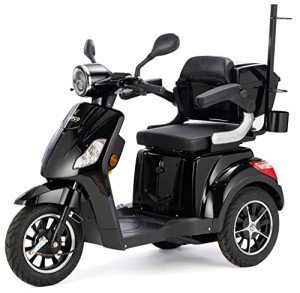Responsible For A Buying Mobility Scooter Budget? 12 Best Ways To Spend Your Money

A Comprehensive Guide to Buying a Mobility Scooter
Mobility scooters have actually become an important tool for many individuals seeking to enhance their independence and mobility. With a vast variety of designs and functions readily available, choosing the best mobility scooter can be intimidating. This post supplies a useful guide to help customers navigate their options, evaluate their requirements, and make an informed purchase.
Understanding Mobility Scooters
Mobility scooters are electric lorries designed for individuals who experience mobility obstacles. They are especially useful for seniors, those with impairments, or people recuperating from injuries. Mobility scooters can differ widely in terms of design, features, and rates.
Types of Mobility Scooters
Before starting a purchase, it's necessary to understand the various types of mobility scooters readily available:
Three-Wheel Scooters:
- Generally more maneuverable in tight spaces
- Lightweight and portable
- Perfect for indoor use
Four-Wheel Scooters:
- Offer greater stability and balance
- Ideal for outside use over numerous surfaces
- Usually have a longer battery life
Foldable/Portable Scooters:
- Designed to be easily transferred and saved
- Can often fit in the trunk of a car
- Perfect for those who take a trip regularly
Durable Scooters:
- Built to accommodate bigger people
- Frequently come with more robust functions for outdoor use
- Normally geared up with bigger batteries for prolonged variety
Factors to Consider When Buying a Mobility Scooter
1. Weight Capacity
Pick a mobility scooter that can support the user's weight. The majority of scooters have a weight limitation varying from 250 to 500 pounds. It is important to make sure that the scooter can accommodate the user easily.
2. Range and Battery Life
The range is how far the mobility scooter can travel on a single charge. Common varieties differ in between 10 to 30 miles. Consider the user's everyday activities and pick a scooter with a suitable range.
3. Scooter Dimensions
Think about the size of the scooter, including its weight and dimensions. A more compact scooter might be ideal for narrow hallways and tight areas, while bigger designs use additional stability and convenience.
4. Surface Capability
Examine where the scooter will mainly be used. If the user prepares to travel mainly on pavement, a lightweight model might be adequate. Nevertheless, if the user needs to pass through gravel or unequal surface areas, consider a four-wheel scooter built for off-road usage.
Leading Features to Look For
Comfort
- Adjustable Seats: Look for scooters with cushioned and height-adjustable seats to make sure convenience during travel.
- Armrests: These boost safety and assistance while browsing.
Security and Visibility
- Headlights and Taillights: Essential for nighttime usage.
- Turn Signals and Reflectors: Improve presence and safety while on the roadway.
User-Friendly Controls
- Joystick or Drive Controls: These should be user-friendly and simple to control.
- Easy-to-Read Displays: A control board that shows battery life, speed, and range can improve the user experience.
Extra Features
- Storage Compartments: These provide included benefit for carrying personal products while on the go.
- Weather Protection: Consider models with rain covers or windscreens if utilized in variable weather conditions.
Cost Considerations
When budgeting for a mobility scooter, rates can vary anywhere from ₤ 500 to over ₤ 5,000 depending on the model, functions, and brand. Extra expenses might include:
- Extended Warranty: Protects versus problems and can conserve money in the long run.
- Devices: Optional functions, such as updated seats, lights, or storage options.
| Function | Expense Range |
|---|---|
| Basic Models | ₤ 500 - ₤ 1,500 |
| Mid-Range Models | ₤ 1,500 - ₤ 3,000 |
| High-End Models | ₤ 3,000 - ₤ 5,000 |
Financing Options
Numerous sellers use funding strategies, and some city government initiatives may supply grants or help for those in requirement. Investigate prospective monetary assistance with neighborhood resources or mobility service organizations.
Frequently asked questions about Buying a Mobility Scooter
What is the distinction between a mobility scooter and a wheelchair?
Mobility scooters are motorized and allow users to navigate individually, while wheelchairs may require physical assistance or manual operation.
How do I keep a mobility scooter?
Routine upkeep involves inspecting battery life, cleaning up the scooter, and inspecting tires and brakes. Always refer to the user handbook for particular guidelines.
Can mobility scooters be utilized inside your home?
Yes, many designs are designed for both indoor and outdoor use. Nevertheless, click hyperlink -wheel scooters tend to be better matched for indoor navigation due to their tighter turning radius.
Are mobility scooters covered by insurance?
Some insurance coverage plans cover a portion of the costs for mobility scooters if they are deemed medically needed. Contact your provider for specific information.
How quickly can a mobility scooter go?
Many mobility scooters have an optimal speed varying from 4 to 8 miles per hour. However, the appropriate pace might differ depending upon regional policies.
Getting a mobility scooter can substantially improve one's independence and lifestyle. By comprehending the types, functions, and expenses associated with mobility scooters, potential purchasers can make knowledgeable choices that fit their requirements and preferences. Customization and extensive research are crucial to guaranteeing complete satisfaction with this important investment.

